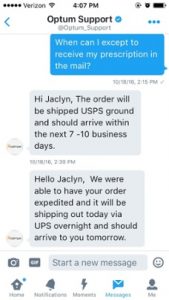One day she discovered she could understand engineers, leading Megan Michuda to a stellar career in marketing tech for the financial services industry.
Our “Spotlight on the expert” series digs deeper into the stories of our expert contributors. This interview has been edited for clarity and length.
Denver, Colo., native Megan Michuda has been wrangling martech in the finance space for almost 14 years. She’s an advisor to martech stack management platform CabinetM and built her own stack management tool Stacktus that CabinetM later acquired. Plus, she’s a MarTech contributor.
Q: You did a B.A. in history at Brown. Then you worked as a marketing specialist developing mobile apps. Then you went back to college and got into information and communication technology for your Master’s. Can you tell us more about that journey?
A: When I was a history major at Brown, I thought I wanted to get into journalism. I played basketball and I was editor of the sports section of the school paper. After taking a journalism class there I realized I did not want to pursue journalism as a career, much as I enjoyed some aspects of it. I kind of just stumbled into marketing.
I got an internship at Dish Network, really to get back to Colorado. They put me in the marketing department and pretty quickly I realized that, although I didn’t have a technical background, I had an aptitude for understanding the technology side of things. So I was in a product marketing, product development role, working a lot with the engineering team, building mobile apps. Kind of a happy accident. At my next role (Janus Capital Group that later went through a merger and became Janus Henderson), I worked on their web content, started to get into email marketing and realized I should probably go back to school and learn to serve as a translator between the IT team and the marketing department. That’s why I went back to school at night to get that degree.
Q: So you were studying while you were working at Janus?
A: Yes.
Q: Did it come as a surprise to you that you had this aptitude for technology?
A: It was a revelation, I think. It wasn’t something I thought about growing up. When I graduated from school, a lot of new technology was certainly coming out — social media, Facebook was just launching, the iPhone was relatively new, so certainly as a consumer you are adopting new technologies as they come out but it hadn’t occurred to me I had an aptitude for it in any way. Once I got into that job and was invited to meetings with engineering teams, I was able to really quickly understand what they were talking about. That was a new discovery.
Q: At Janus Henderson you grew from a relatively junior role to being global head of marketing technology.
A: It was an incredible experience at that company. I started out in a specialist position, working on content management. I was curious if anybody was actually reading what we were putting out there. It’s not that web analytics were new at the time, but financial services companies were maybe behind the curve a little bit — partly because of being a heavily regulated industry.
I did my own research on web analytics and Google Analytics. The company supported me in carving out a role for myself and it kind of snowballed from there. You start thinking about, could we get more information about this, and that led me to Scott Brinker and that whole world. That’s when it really clicked: This is my lane.
Q: You developed Stacktus during your time at Janus? In your spare time?
A: Once I finished my degree I was doing at night, I suddenly felt like I had all this time on my hands, so yes, Stacktus was something I did on the side.
Q: What was the idea behind Stacktus?
A: I’d always listened to a lot of entrepreneurial podcasts so I kind of had that itch to try something on my own. Working in marketing technology, building my own stacks and trying to keep my own documentation around our current stack and the roadmap — I struggled at that time to find a tool that did everything I needed. So I thought, why not try and build something? My husband is in product development, so between the two of us we took on trying to build Stacktus. I had the vision for what was needed from the features and functionality perspective. We bootstrapped it ourselves; sourced it to developers we found on UpWork and places like that.
We got a couple of early customers. I got to the point where I realized I really liked the product aspect of it but I didn’t like the sales aspect — also, I was getting ready to have a baby. I was in touch with Sheryl [Schultz, CabinetM co-founder] and I had the opportunity to sell Stacktus and act more as an advisor to CabinetM.
What I learned about myself is that I’m not brave enough to go fully into entrepreneurship. I was curious to scratch that itch, but I’m not that big of a risk taker.
Q: Was there something you were doing at Stacktus that CabinetM wasn’t then doing?
A: If I remember correctly, they weren’t doing as much from a visual diagramming perspective, like their Stack Maps. I don’t want to take full credit for that feature but that wasn’t live at the time and it was something we were doing with Stacktus, visually diagram the stack and organize it in different ways.
Q: Back to Janus Henderson. You had responsibility for teams around the world?
A: Originally I was the head of marketing technology at Janus, and we were headquartered in Denver. Then we went through a merger with Henderson Investors in London. That is how my role very quickly became global. I had a few team members in London that I managed. The merger was a great challenge from a career perspective because we were having to merge two different instances of Salesforce, two different web platforms, two different email marketing platforms. When we were a Denver-based company we didn’t need to translate our web content. Now suddenly we needed to translate it into dozens of languages because Henderson was not only in Europe but also in Asia.
The global perspective was fascinating, learning about different cultures. I got to go to London a bunch.
Q: Then the transition to your current role at BOK Financial?
A: A former boss of mine at Janus has taken over at BOK Financial as the CMO, so he reached out about having me run the same playbook because they didn’t have a marketing technology team. Different company, different size company — I had been at Janus for a long time. Also, at that point I had children, so the trips to London weren’t quite so appealing on a personal level.
Q: You’re from Denver and you’ve handled your career so that you’re still in Denver. You must like Denver.
A: I love Denver. All the mountain recreation I grew up doing — skiing, mountain biking, hiking — I’ve managed my career to stay in Denver. BOK has a large office in Denver but the headquarters is in Tulsa, so I also travel to Tulsa on a regular basis. Most of my team is based there.
The post Megan Michuda: Spotlight on the expert appeared first on MarTech.
MarTech(16)
Report Post






